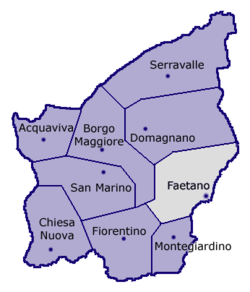This article needs additional citations for verification .(February 2024) |
Monte Pulito | |
|---|---|
 Location of Faetano within San Marino | |
| Coordinates: 43°55′31.26″N12°29′0.72″E / 43.9253500°N 12.4835333°E | |
| Country | |
| Castello | |
| Elevation | 250 m (820 ft) |
| Demonym | montesi |
| Time zone | UTC+1 (CET) |
| • Summer (DST) | UTC+2 (CEST) |
| Postal code | 47896 |
| Area code | +378 (0549) |
Monte Pulito is a curazia of San Marino, in the castello of Faetano. [1] [2]
